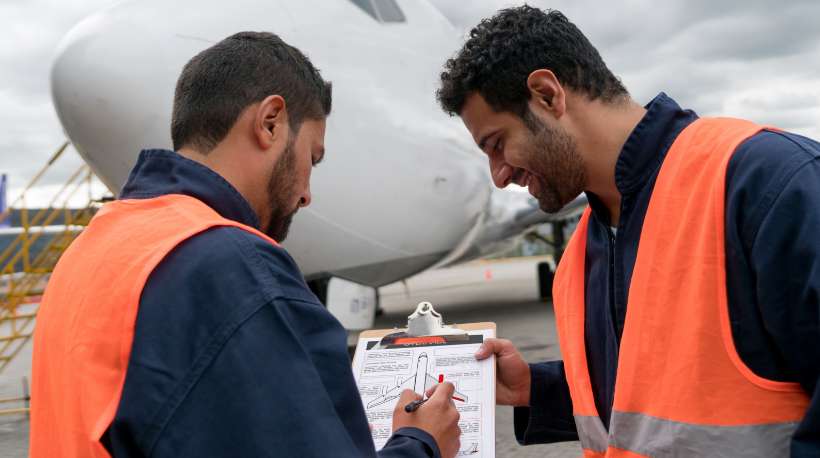Regular maintenance for general aviation planes, including inspections, is crucial to ensure safety and reliability in the air. Following an aircraft inspection checklist is essential to preventing mechanical failures and preserving the life of the aircraft, according to Federal Aviation Administration (FAA) regulations.

What Is Preventive Maintenance?
Aircraft preventive maintenance is any preservation or replacement work that does not involve complex assembly operations. A preventive aircraft maintenance checklist includes replacing, servicing or repairing small standard parts. Aircraft preventive maintenance typically takes place regularly and is crucial for preventing significant problems from occurring during flight. Standard aircraft preventive maintenance tasks generally include:
- Running Tests
- Checking for Wear
- Lubricating and Cleaning Components
- Replacing Acceptable Items
- Adhering to Required Inspections for Aircraft
What Is an Aircraft Inspection Checklist?
An inherent part of aircraft preventive maintenance — and a responsibility of owning a general aviation aircraft required by the Federal Aviation Administration (FAA) — is following an aircraft inspection checklist. Title 14 of the Code of Federal Regulations states that "the owner/operator of a civil aircraft is primarily responsible for maintaining that aircraft in an airworthy condition, including compliance with FAA Airworthiness Directives (AD)." By following an aircraft inspection checklist, owners and operators can:
- Prevent Mechanical Failures and Ensure Flight Safety: Mechanical failures account for nearly a quarter of all fatal aircraft accidents. Airplane inspections can help identify hazards early to guarantee the pilot's safety.
- Preserve the Life of the Aircraft: Aircraft are designed to operate within certain cycle limits, determining their lifespan. Through an aviation inspection, owners can keep components working their best to ensure safe flights throughout that lifespan.
- Minimize Aircraft Downtime: In aircraft operations, every second is valuable. By regularly performing required inspections, aircraft will have less downtime and fewer major repairs, which can benefit an owner's bottom line.
Types of Aircraft Maintenance Inspections
Required inspections for aircraft take on two different forms: scheduled and unscheduled. When unscheduled aviation inspections are unforeseen and sudden, scheduled inspections take on a much more rigid structure. Under the category of scheduled airplane inspections, there are several subcategories and types of aircraft maintenance inspections that technicians and pilots must perform.
100-Hour Inspection
A 100-hour airplane inspection is a thorough examination of an aircraft as required by Federal Aviation Regulations (FARs). As the name implies, this inspection is to be performed every 100 hours of service. In some cases, 100-hour airplane inspections may also be required after major maintenance tasks, such as installing a new propeller or a complete engine overhaul.
Annual Aircraft Inspections
The FAA also requires every plane to undergo an annual inspection performed by a licensed mechanic with inspection authorization. Pilots can perform informal annual aircraft inspections at any time, but it's essential to obtain an official inspection performed by a licensed mechanic once a year to meet the requirement. If an owner fails to meet this requirement, pilots may not fly the aircraft without authorization.
Progressive Inspections
If an operator's fleet is heavily utilized (e.g., flight school, corporate and fixed-base operator fleets), they may undergo a progressive inspection plan to minimize downtime. These types of aircraft maintenance inspections are complete inspections conducted in separate stages to be completed throughout 12 calendar months. Unlike a 100-hour or annual aircraft inspection, progressive inspections enable more frequent but shorter inspection programs as long as the FAA approves them.
Pre-Flight Inspections
Pre-flight checks are airplane inspections conducted by pilots (or student pilots) before takeoff to verify the aircraft is safe for departure. With the help of a pre-flight aircraft inspection checklist, they can conduct a walk-around to determine whether major components are functioning normally — and note if any defects need immediate repair. A pre-flight aircraft inspection checklist typically focuses on the following areas:
- Exterior: Check for corrosion, damage, dents, dirt and ice. Make sure that all aircraft structural hardware is tight and undamaged.
- Wings and Flaps: Ensure the wings and flaps are free from cracks, dents or bends. Ailerons, actuators and flaps should also be working and adequately lubricated. If your fuel tanks are located in the wings, check for leaks. Finally, ensure the aircraft position lights are in working order.
- Engine: A properly functioning engine is vital for any flight. Carefully inspect the engine parts and engine cylinders for possible corrosion, worn gaskets and leaks. It's also important to make sure the engine is clean and dry.
- Landing Gear: Check whether the tires have any wear or damage. If the tires are worn or damaged, they need to be replaced. Landing gear components should also be checked for damage or cracks, and the lights should have working bulbs.
- Tail: Ensure the rudder and elevator are free from wear, lubricated and working correctly. Inspectors should also check the horizontal and vertical stabilizers.
- Propeller: If an aircraft contains one or more propellers, ensure they (and the spinner) are functioning normally and undamaged.
- Cabin and Cockpit: Check the fuel and oil pressure, radio settings, transponder code, navigation instruments, flight control surfaces, database currency and flight plan entry. It's also vital to check airframe hardware, such as seats and safety belts, for any signs of damage and wear. Safety belts should be able to clasp and unclasp. The heat and A/C should also be working correctly.
- Hydraulic System: If your aircraft has a hydraulic system, ensure that the reservoirs have the recommended amount of fluids. Additionally, you should confirm the hydraulic connections and hose connections are secured.
- Doors and Windows: Ensure the doors, windshields and windows are intact, clear and properly attached.
Air Power Inc. Makes Aircraft Preventive Maintenance Easier
Completing standard aircraft preventive maintenance is essential for owning a general aviation aircraft. Without an aircraft inspection checklist to complete your work, you're putting your aircraft (and yourself) at risk of an accident. Remember that aircraft maintenance requirements exist for a reason.
If you run into any issues while completing your aircraft maintenance checklist and need to replace any parts, look to Air Power Inc. We're proud to be the largest supplier of aircraft parts and components in the world, so we're sure to have what you need for your unique make and model at the lowest prices in the industry. Browse our entire selection of parts today. If you have any questions about parts to complete your required inspections for your aircraft, don't hesitate to reach out and contact us. We're here to help.
Shop Aircraft Parts Today

